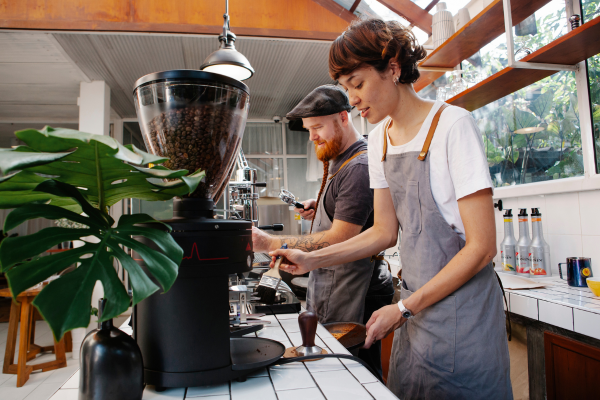You might think the secret to great coffee lies solely in the beans. While quality beans are essential, another tool plays an equally critical role.
That’s your coffee grinder. It’s not just about breaking down beans. The way your grinder processes coffee fundamentally defines its final flavor.
Many coffee lovers overlook the importance of their grinder. Yet, it’s the very first step in unlocking your coffee’s potential.
An inconsistent grind can ruin even the most expensive beans. This article will explore the profound impact of your grinder. It will show how it shapes every aspect of your coffee’s taste, aroma, and body.
The Science of Extraction: Why Grind Size Matters
Coffee brewing is an act of extraction. Hot water dissolves desirable compounds from coffee grounds. These compounds include acids, sugars, and oils. They create the complex flavors and aromas we love.
The grind size dictates how quickly and evenly these compounds extract. It determines the surface area of the coffee particles. A larger surface area allows for faster extraction. A smaller surface area slows it down.
If the grind is too coarse, water passes too quickly. This results in under-extraction. Your coffee will taste sour, watery, and weak. It won’t have developed its full flavor.
If the grind is too fine, water struggles to pass through. This causes over-extraction. Your coffee will taste bitter, astringent, and harsh. It will have an unpleasant aftertaste.
The goal is to achieve a balanced extraction. This means dissolving just the right amount of compounds. A consistent grind size is crucial for this balance. It ensures all particles extract at a similar rate.
The Problem with Blade Grinders: Inconsistency is the Enemy
Many common grinders use spinning blades. These are often called blade grinders. They operate by chopping coffee beans. This method is quick and often inexpensive.
However, blade grinders do not grind coffee. They smash and pulverize it. This creates a highly inconsistent mix of particles. You’ll find fine powder alongside larger chunks.
This inconsistency leads to poor extraction. The fine particles over-extract rapidly. They release bitter compounds. The coarse particles under-extract, contributing sourness.
The result is a muddled cup. It can taste both bitter and sour at once. Blade grinders also generate heat through friction. This can prematurely degrade delicate aromas. They simply cannot provide the control needed for quality coffee.
The Precision of Burr Grinders: Uniformity for Flavor
For true coffee quality, a burr grinder is essential. These machines use two abrasive surfaces, or burrs. Coffee beans are milled between these burrs. This produces a consistent and uniform grind.
Burr grinders allow for precise adjustment of grind size. You simply change the distance between the burrs. This control is vital for matching the grind to your brewing method. It ensures optimal extraction every time.
There are two main types of burr grinders:
- Conical burr grinders use a cone-shaped inner burr. This rotates inside a ring-shaped outer burr. They are known for efficiency and quieter operation. They produce less heat, preserving flavor.
- Flat burr grinders use two flat, parallel burrs. They produce a very uniform grind. They are often preferred by espresso enthusiasts.
Investing in a burr grinder is perhaps the single most impactful upgrade. It provides the foundation for consistent, flavorful coffee. It’s the key to unlocking the true taste of your beans.
How Grind Size Influences Specific Brewing Methods
Each coffee brewing method has unique requirements. The ideal grind size depends on the contact time with water. It also depends on the specific filtration method.
Coarse Grind: For Longer Extraction Times
A coarse grind resembles sea salt or breadcrumbs. Water flows through it quickly. This is ideal for methods with long immersion times.
- French Press: The grounds steep fully in water. A coarse grind prevents over-extraction. It also minimizes sediment in the cup.
- Cold Brew: Coffee steeps for 12-24 hours in cold water. An extra coarse grind prevents excessive bitterness. It ensures a smooth concentrate.
- Percolator: Water cycles through the grounds repeatedly. A coarse grind prevents over-extraction. It also avoids clogging the filter.
Medium Grinds: For Balanced Filtration
Medium-coarse to medium grinds are like rough to regular sand. They offer a balanced flow rate. They are suitable for various popular methods.
- Drip Coffee Makers: Most automatic drip brewers perform best with a medium grind. This allows for even extraction as water passes through.
- Chemex: This method uses a thick filter. A medium-coarse grind prevents slow dripping. It produces a very clean cup.
- Pour-Over (e.g., Hario V60, Kalita Wave): A medium-fine grind is often preferred. It allows for efficient extraction during the manual pour. This highlights nuanced flavors.
- Aeropress: This versatile brewer can use various grind sizes. For a standard immersion, a medium grind works well. For an espresso-like concentrate, a fine grind is used.
Fine Grinds: For High Pressure and Quick Contact
A fine grind feels like table salt or powdered sugar. Water has very short contact time. This requires maximum surface area for efficient extraction.
- Espresso Machines: Espresso relies on high pressure and short contact. A fine grind provides the necessary resistance. This allows for full flavor extraction and crema formation.
- Moka Pot: This stovetop brewer uses steam pressure. A fine grind is needed to create sufficient pressure. It produces a strong, concentrated coffee.
- Turkish Coffee: This method boils coffee grounds directly in water. An extra-fine, flour-like grind is required. This allows the coffee to dissolve and create a thick body.
Beyond Grind Size: Other Factors Influencing Flavor
While grind size is paramount, other grinder-related factors also impact flavor. These subtle elements contribute to your final cup.
Heat Generation
Grinders produce heat during operation. Blade grinders generate significant heat due to friction. This heat can prematurely degrade delicate aromatic compounds in the coffee. This leads to a flatter, less vibrant flavor.
Burr grinders produce less heat, especially conical burrs. This helps preserve the coffee’s volatile oils and aromas. Choosing a grinder that runs cooler is beneficial for flavor integrity.
Retention and Static
Some grinders retain small amounts of ground coffee. This retention means old grounds mix with fresh ones. Old, stale grounds can impart off-flavors to your fresh brew.
Static electricity can also be an issue. It causes coffee grounds to cling to the grinder. This leads to mess and can also contribute to retention. Grinders with anti-static features are often cleaner and more efficient.
Minimizing retention and static ensures only fresh grounds go into your brew. This maintains peak flavor and a cleaner workspace.
Burr Material and Sharpness
The material and sharpness of the burrs matter. High-quality burrs are typically made from hardened steel or ceramic. They retain their sharpness longer. Sharp burrs cut coffee beans cleanly. Dull burrs can crush or smash them.
A clean cut produces a more uniform grind. This leads to better extraction. Regularly cleaning your burrs helps maintain their sharpness. It prevents oil buildup that can dull them.
Maintaining Your Grinder for Optimal Flavor
Proper grinder maintenance is crucial. It ensures consistent performance and preserves flavor. Neglecting your grinder can quickly degrade your coffee’s taste.
Regular Cleaning
Coffee beans contain oils. These oils can build up on the burrs and in the grinding chamber. Over time, these oils become rancid. They impart bitter, stale flavors to your fresh grounds.
- Daily Brushing: Use a dedicated brush to remove loose grounds after each use. This prevents buildup.
- Weekly Deep Clean: Disassemble your grinder (if possible). Use a brush and a vacuum to remove all grounds and oils. Follow manufacturer instructions for disassembly.
- Grinder Cleaning Tablets: These tablets (made of food-safe material) can be ground like coffee beans. They absorb oils and remove old coffee residue. Use them periodically.
Regular cleaning prevents cross-contamination of flavors. It ensures every brew tastes fresh and true to the bean.
Calibration and Adjustment
Over time, burrs can become misaligned. This can affect grind consistency. Some grinders allow for calibration. Refer to your grinder’s manual for specific instructions.
Always recalibrate after a deep cleaning. This ensures your grind settings remain accurate. A well-calibrated grinder provides consistent, repeatable results.
Burr Replacement
Burrs wear down over time, especially with frequent use. Dull burrs produce an inconsistent grind. They can also generate more heat. Most manufacturers recommend replacing burrs periodically.
The lifespan of burrs depends on material and usage. Hardened steel burrs typically last for hundreds of pounds of coffee. Ceramic burrs are often more durable. Replace them when you notice a drop in grind quality or consistency.
The Consumer’s Role: Understanding and Investing
As a coffee lover, understanding your grinder’s impact is empowering. It allows you to make informed decisions. It transforms your brewing from guesswork to precision.
Invest Wisely
Consider a quality burr grinder as a long-term investment. It will pay for itself in consistent flavor. It will also reduce waste from bad brews. It’s the most important piece of home coffee gear.
Research different models and read reviews. Look for features that match your needs. Prioritize consistency and durability.
Experiment and Learn
Don’t be afraid to experiment with grind settings. Small adjustments can yield significant flavor changes. Keep notes on what works for different beans and brew methods.
Learn about your specific brewing method’s grind requirements. Understand how water flow and contact time interact with grind size. This knowledge will elevate your brewing skills.
Appreciate the Grind
Take a moment to appreciate the process. The sound of freshly ground coffee. The aroma released. It’s the first step in the sensory journey of coffee. It sets the stage for a perfect cup.
Your grinder is not just a machine. It’s an essential tool. It bridges the gap between raw beans and delicious coffee. It truly defines your coffee’s flavor.
Considerations Finals: The Grinder’s Undeniable Influence
The journey from bean to cup is complex, and at its very beginning lies the coffee grinder—a tool whose impact on flavor is often underestimated.
Your grinder doesn’t just prepare the coffee; it dictates how flavor compounds are extracted, shaping the sweetness, acidity, body, and bitterness of your final brew.
Investing in a quality burr grinder, understanding grind consistency, and maintaining your equipment are pivotal steps toward unlocking the full potential of your coffee beans.
Embrace the power of the grind, and transform every cup into a testament to precision and unparalleled flavor.

